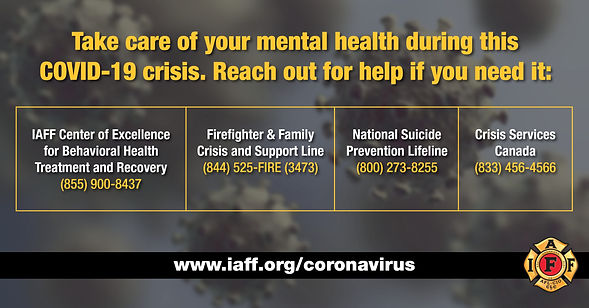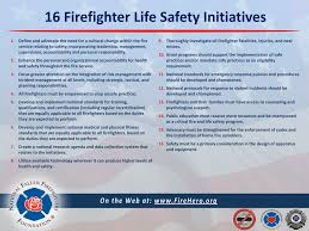
In 2004, the 16 Firefighter Life Safety Initiatives were jointly developed by reps of the major fire service constituencies. Thereafter, the National Fallen Firefighters Foundations was entrusted with developing material to support their implementation. Click on the attached imagine to access this material directly from everyonegoeshome.com.

The Rules of Engagement for Structural Firefighting
"The Rules recognize that those at most risk are the firefighters and company officers operating in the hazard zone and so integrate them into the risk-assessment and decision-making process. THE RULES ALLOW THEM TO SAY NO TO UNSAFE CONDITIONS OR PRACTICES AND REPORT SUCH SITUATIONS, WITHOUT PENALTY, THROUGH A STRUCTURED PROCESS.
Because the development process involved so many national fire service organizations and broad public comment to achieve consensus, along with an increasing number of organizations and individual fire departments that are formally adopting the Rules of Engagement, they have now evolved to the point fo being considered a standard of practice for the fire service."
Reference: Rules of engagement can save firefighter lives. (n.d.). Retrieved March 02, 2021, from https://www.iafc.org/iCHIEFS/iCHIEFS-article/rules-of-engagement-can-save-firefighter-lives
The Rules of Engagement for Structural Firefighting focus on the fire fighter and fire officer working at the task level of fire suppression operations. Covering high-risk operations in a high-hazard environment required that the rules meet the following criteria:
- Be a short, specific set of bullet points
- Be easily taught and remembered
- Define critical risk issues
- Define "go" and "no go" situations
Reference: Ward, M. J. (2015). Fire officer: Principles and practice (Third ed.). Platte City, Missouri: Jones & Bartlett Learning.

Occupational Cancer in the
Fire Service
Health and Safety
Firefighter life safety starts with every firefighter doing their part. Links to a few important websites that contain a great deal of health & safety information are provided in this section. Also, contact information for several crisis support resources are provided below.





Click on the attached image to review the 11 Best Practices for Preventing Firefighter Cancer

Firefighter Cancer Support Network
Cancer is the most dangerous threat to firefighters health and safety today.
~Cancer caused 66% of career firefighter LODDs from 2002 - 2019, according to data from the IAFF.
~Cancer caused 70% of LODDs for career firefighters in 2016
~Firefighters have a 9% higher risk of being diagnosed with cancer and a 14% higher risk of dying from cancer than the general U.S. population, according to research by the CDC/NIOSH
Click on the attached image to review
this information in greater detail.
Resource: FAQ. (2020, December 30). Retrieved March 02, 2021, from https://firefightercancersupport.org/resources/faq/
Fire Ground Safety
POWER LINES & ENERGIZED ELECTRICAL EQUIPMENT
Overhead and underground power lines & energized electrical equipment present a significant life safety hazard to us as firefighters. Below are a list of key points related to this topic.
-
Downed lines must always be considered energized with potentially lethal current
-
Lines can reset and become "hot" or "energized" again by manual operation of a switch, by automatic re-closing methods, by induction where a de-energized line can become hot if it's near an energized line, or through back feed conditions
-
Power line tends to have "Reel Memory" and may curl back or roll on itself when down
-
Use caution when spraying water on or around energized electrical equipment. HOSE STREAMS CONDUCT CURRENT. Never spray directly into the power lines. Use a fog spray at the base of the pole. The primary objective is to protect the surrounding area. Short bursts of water are preferred methods to avoid being grounded. (SEE THE VIDEO BELOW)
-
Never spray water onto electrical equipment until a utility rep has confirmed that the equipment is de-energized or "dead"
-
Electrical equipment is classified as:
-
Energized
-
De-energized (Cannot be 100% guaranteed. Therefore, treat as energized)
-
Dead (Confirmed by utility representatives after grounding the line(s))
-
-
PCB hazards: Smoke potentially fatal (Avoid and contain pools of oil around transformers
-
Voltage of a power line cannot be determined by the the size of the conductor. Most overhead conductors are not insulated
-
Voltage can travel through both dry and especially wet ground for considerable distances
-
Pad-mounted and overhead transformers can explode
-
Until grounded, equipment can contain electric potential, which can cause severe injury or death
-
Electricity can flow through the ground or other conductive objects, such as fences, to points far from the scene
Electricity will travel any conductive path it can as it seeks a ground. A direct path to ground can occur when contact is made between something energized and a portion of your body such as your hand, arm, head, or other body part. An indirect path to ground occurs when you are holding something or touching an object that is in contact with something energized. This could be indicated by a tingling sensation in the feet and serve as a warning to back away from the area. Step potential is more severe when the ground is wet.
The 22 minute video below is of a Live Wire Demonstration from Dominion Energy that has been uploaded to YouTube. Watch the video to learn more about pertinent safety information as it pertains to our department responding to downed power line emergencies.
Step & Touch Potential

-
Step potential: the voltage difference between your feet when you are standing near a downed power line and your feet in different rings of electrical current with different voltages. The difference in voltage between your feet can cause the electrical current to enter and surge through your body. This phenomenon is illustrated in the picture below.
-
Touch potential: how you can be electrocuted or suffer an electric shock if you touch an object that has been electrified or energized by a downed power line or any conductor of electricity. The electrical current flowing through the object enters your body through your hand and leaves through your feet, causing damage to your internal organs.






